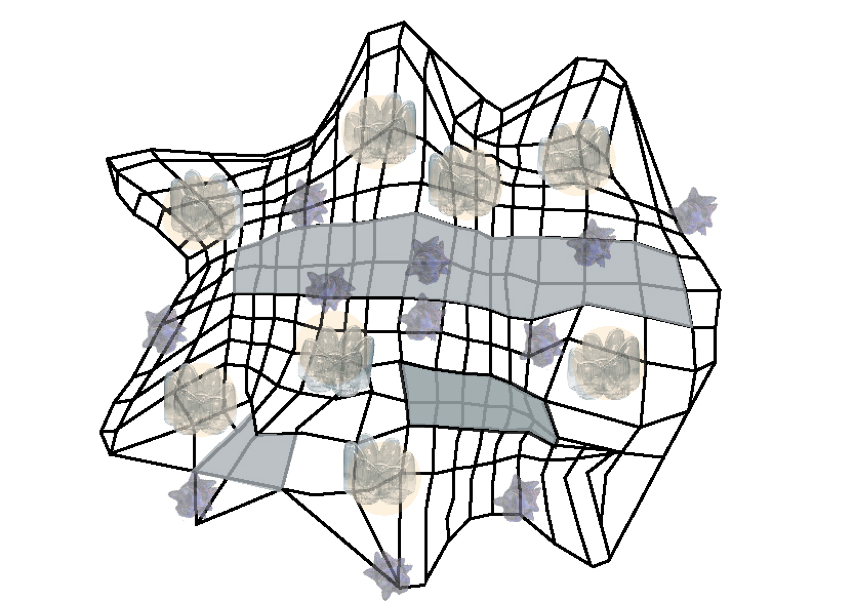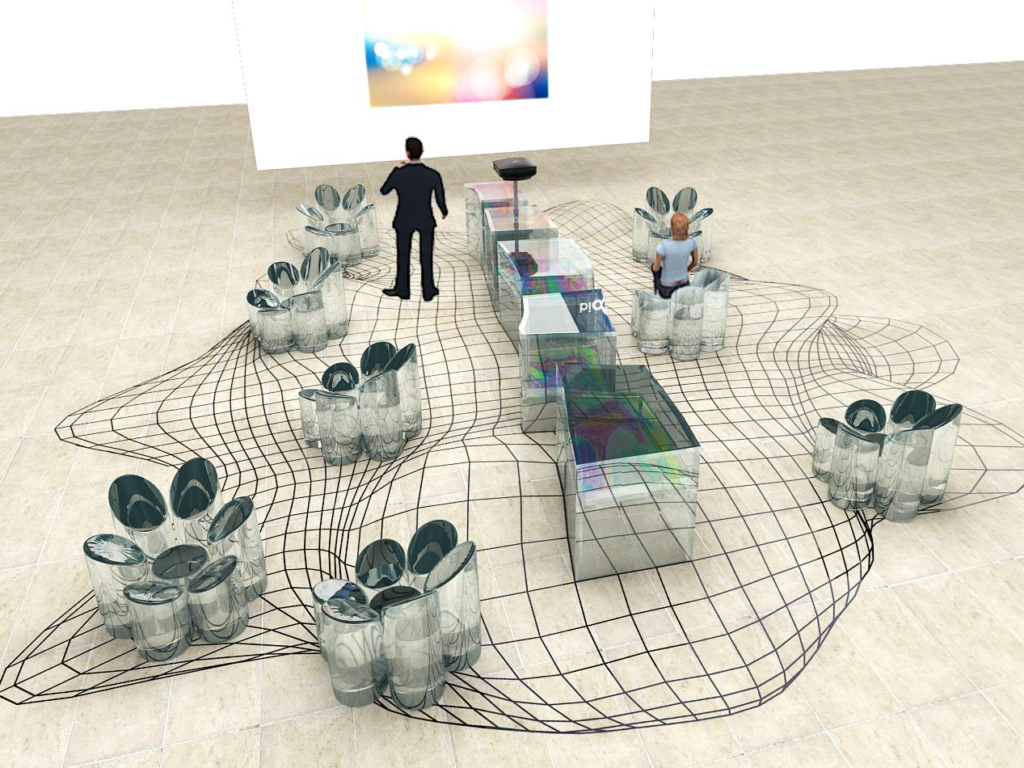The Biobbles Pop Up & Display Case Exhibition
INTRODUCTION
About
The Biobbles Pop Up was an “off space” designed as a satellite meeting point for relaxation and communication. Visitors to the space could sit and talk as well as enjoy a five-part exhibition that including projects ranging from “silly science” to “serious science” as well as projects that focused on “reinterpreting” traditional Korean cultural goods through the imagination of those who have come to that culture from outside the country. These “hybrid” works were of particular interest to all, because they were able to show how cultures can converge through cosmo-cultural vision and what role the imagination can play in reshaping traditions. The resultant projects are clear examples and proofs that traditions are constantly evolving into new forms while at the same time are able to retain their intrinsic meaning.

Fig. 1. Biobbles Pop Up Café Space with Blow Up Chairs and Display Cases
Origin
The Biobbles Pop Up Space is a follow-up project of the Digital Art Week Seoul 2014 and the Virtually Switzerland in Seoul project. Exhibitors were mostly taken from those participating in the festival and included: Biocon Labs, Arthur Clay (CHE), Simone Carena (ITL/KOR), The Curious Minded (CHE), and Monika Rut (POL), Wayne de Fremery (KOR) and Andrew Davidhazy (USA), amongst others.
Closing Virtuale Switzerland in Seoul
The event marked the closing of the Virtuale Seoul. The project opened on 8 October 2014 and remained accessible for the public until 31 July 2015. Virtuale stands for virtual biennale and is a festival for public space using new digital tools not only to view the artwork and to interact with them, but also to design the experience of participation itself. Artists included Curious Minds + Guests (CHE), Lalie Pascual (CHE), John Craig Freeman (USA), Caroline Bernard (CHE), Peter Aerschmann (CHE), and Michael Spahr (CHE). Venues included Museum of Art Seoul National University, Seoul Station, and Seoul Station Square, and the open areas of the National Palace, National Palace.
PROJECTS
DNA Bubble Blower by The Curious Minded
This is a silly science project that is like DYI science but where there is aspect of humor while still being science based. Basically, it is a bubble blower using the structure of DNA, which is like a ladder twisted into a spiral and at each step of the ladder is a pair of nucleotides. The concept behind it is imaginative and makes use of the process DNA mutation where mistakes are sometimes made and lets evolution move forward. With the DNA Bubble Blower fantasy is the key factor in causing the mutation and it is here where the DNA bubble blower shows its true identity. Users are asked to use their fantasy as the bubbles flow through the air and at points in time combine with objects in the environment and provide eyes and now to such things as puddles, pot holes, and other things.

Fig. 2. Cases with “Games and Wonderments” & “DNA Bubble Blower” Projects
21st Century Games & Wonderments by The Curious Minded
The title refers to a collection of works with which the intentions of the art group are apparent: to create a state of mind to kindle a smile on the face of the observer through creative engagement. From this series, the Earth Cell Game was exhibited, which is a bioart board game in the form of an art multiple. It was developed initially as a game to reduce rigidity in autistic children. It success in doing so echoes the intentions of the art group to record moments of curiosity as wonderment, as proof of a concept, as benchmarks of a friendship, as a concrete but pluralistic exchange.
Hanok Dub Acid Remix by Motoelastico
This is the original model of the “hanok dub acid remix” project by Motoelastico, an Italian design company located in Seoul. The Hanok Dub project is the first renovation of Korean Traditional architecture into a design which retains its origins but at the same time adopts innovations. Architectural Review and the New York Times both featured it with articles. The models stands as a rendering in 3D of the dub design metaphor design. Dinosaurs, skeletons, robots, vintage sci-fi, myths and good Italian design are the living force the new “BIO” of an otherwise dead space.
Interference Colors by Andrew Davidhazy
The photographs of a thin film of soap bubble liquid were made by the photographer Andrew Davidhazy in the 1970s. The artist is a former faculty member and chair of the Imaging and Photographic Technology Department at Rochester Institute of Technology and the works represent the technology of that time and also the excitement of one of the high points of analog photography. For these images, the artist made a series of shots of dishwashing detergent floating on water. They were made from close range and with a tilt-capable lens adjusted for Scheimpflug condition to compensate for tilted soap film surface to extend depth of field. The images were recreated as part of the Biobbles Case Design and were UV printed onto acrylic glass plates.

Fig. 3. Cases with the “Armful of Azaleas” and “Hanok Dub Project”
Technologies of Memory and Loss—
An Armful of Azaleas
The project An Armful of Azaleas is a literary project which uses three dimensional models to offer the viewer new insight into aspects of traditional Korean poetry using a well known classic poem as its basis. In the words of the artists, all of the 3D objects on view reproduce different versions of the canonical Korean poem “Azaleas” by Kim So-wŏl (1902-1934) to investigate the institutional systems of cultural memory we call literature, the sociology of literature’s general science, philology, and what has been called literature’s Turing Machine, the critical edition.
ELECTRONIC ENHHANCEMENT
AR Biobbles
In contrast to the pure physicality of the objects on display in the cases, The Biobbles Pop Up Space also offered two electronic enhancements. The first is the Augmented Reality artwork “Biobbles” which can be seen by downloading the free AR Browser LAYAR, scanning in the QR Code on display, and then looking around the hall through your mobile device.

Fig. 4. Augmented Reality Overlay (as seen through iPad)
Biobbles is an AR application that lets the user overlay virtual objects with reality. The app is used to create odd shaped biomorphic bubbles based on 3D objects of the plasma from a multi-molecular protein complex. The user simply clicks on the app icon and the program interface opens. The interface allows the user to choose from an instance of a dynamic plasma in order to select the shape and to set the related parameters for the resulting biomorphic bubble. The parameters include size and color and the selection is made when the finger released from the screen. Once the bubble has been chosen and the parameters set, the user can either choose to blow the bubble, swipe it with a hand motion, or have it generate automatically. The gesture can go on ad lib and the user can blow or swipe as many bubble as he wants. The position of the bubble is determined is relative to the user and appear above his head and then take on the movement described in the settings.

Fig.5. Sketch of floor mesh with the placements of elements.
iBook “Interviews with Innovators”
The second electronic enhancement is an electronic version of the recently published eBook “On Society On Arts On Society: Interviews with Innovators” edited by Arthur Clay, Monika Rut, and Timothy J Senior. The eBook documents a fruitful collaboration between South Korea and Switzerland.
The book features a collection of twenty-five interviews from practitioners originating in diverse and outwardly opposing fields. Divided into three separate chapters, “On Science”, On Art”, and “On Society, authors illustrate to the reader models of hybridity that can validate convergence as a method for nurturing innovation across disciplines. Readers interested in innovation and the processes that drive it, will find that each of the chapters of the book addresses a particular area of knowledge and that each of the interviews offers its own perspective on the subject at hand as well as offering case examples that put theory into practice.
The book is made available for download from Apple Books, or can be viewed on any one of the iPads are provided for viewing the book located in the space
SPACE DESIGN
Visualization
To create the Biobbles Pop Up Space, A 3D mesh was created from one of the elements of a visualization of the multi tRNA synthetase complex that was being used for purposes of scientific illustrations at the Medicinal Bioconvergence Research Center (Biocon). The mesh was then used as a kind of “exoskeleton” which literally dictates the form and placement of each of the elements of the space. A thematic use of transparency was adopted in the design of the space so that regardless of what was placed onto the Mesh, it would not block or distract visually from it but would ornament it optically in novel ways.

Fig. 6. 3D sketch of café plan done by Sessions Company
The five Exhibition Cases were derived from the grid pattern of the matrix and take on an organic form by extending sections of the mesh vertically. The cases are split in two to create a bi-level display unit which not only makes displaying more possible, but features images from Andrew Davidhazy’s study on Interference Colors in Thin Soap Films at each of the cross sections.
The Airflower Inflatable Chairs by Fabrice Berrux designed for Roche Bobois embrace the transparency design factor of the space and provide optical variance to the floor mesh, lending it a certain organic warp when seen through the chair.
The inclusion of a projection system was done to overlay virtual world of Augmented reality on to the real-world design objects so that an element of smartness is introduced to the space and so visitors could explore the overlapping borders between the real and the virtual
ACKNOWLEDGEMENT
The project was part of the BIOCON TECH FAIR 2015 and was made possible by diverse parties including the Medicinal Bioconvergence Research Center, Minister of Science, ICT, and Future Planning, the Digital Art Weeks International, Virtuale Switzerland, and others. We would like to give special thanks goes out to Prof. Sunghoon Kim (SNU) and Medicinal Bioconvergence Research Center for their encouragement and support, to Andrew Davidhazy (Rochester) for letting us integrate is work and research into the design, toAn Jae Yoon (Sogang University) for his assisting with the project, and to Simone Carena (Hongik University), and Wayne de Fremery (Sogang University) for their contributions for the exhibition.
Arthur Clay, July 2015